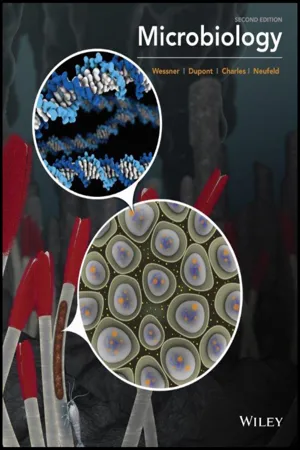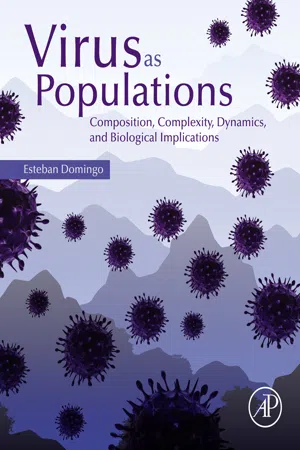Biological Sciences
Viral Replication Cycle
The viral replication cycle is the process by which a virus infects a host cell, replicates its genetic material, assembles new viral particles, and releases them to infect other cells. It involves attachment, penetration, uncoating, replication, assembly, and release. This cycle is essential for the spread and survival of viruses.
Written by Perlego with AI-assistance
Related key terms
7 Key excerpts on "Viral Replication Cycle"
- eBook - ePub
- Britannica Educational Publishing, Kara Rogers(Authors)
- 2010(Publication Date)
- Britannica Educational Publishing(Publisher)
CHAPTER 5Cycles and Patterns of Viral InfectionT he cycles and patterns of viral infection vary depending on the type of virus involved. In order to replicate, however, all viruses must first find a suitable host cell. Whereas some viruses then lie dormant for an indefinite period of time, others set to work appropriating the cells’ genetic replication machinery. The latter is accomplished primarily through the ability of a virus to integrate into host cell DNA. The subsequent manipulation of the host’s genetic machinery results in the generation of numerous viral progeny. When the host cell dies, the progeny are freed to infect new host cells, repeating the infection and replication cycle.The mechanisms of viral infection sometimes involve phenomena such as lysogeny, in which a bacteriophage lies dormant within a host bacterial cell and eventually awakens, replicates, and causes the cell to break open (lyse), and malignant transformation, in which animal cells infected with certain viruses are transformed into cancer cells. In addition to cancer, viral infections in humans also underlie various other diseases, ranging from gastrointestinal illness to influenza to AIDS. Thus, the development of vaccines to prevent infection and of antiviral drugs to treat infection form important areas of research at the crossroads of virology and medicine.THE CYCLE OF INFECTION
Viruses can reproduce only within a host cell. The parental virus (virion) gives rise to numerous progeny, usually genetically and structurally identical to the parent virus. The actions of the virus depend both on its destructive tendencies toward a specific host cell and on environmental conditions. In the vegetative cycle of viral infection, multiplication of progeny viruses can be rapid. This cycle of infection often results in the death of the cell and the release of many virus progeny. Certain viruses, particularly bacteriophages, are called temperate (or latent) because the infection does not immediately result in cell death. The viral genetic material remains dormant or is actually integrated into the genome of the host cell. Cells infected with temperate viruses are called lysogenic because the cells tend to be broken down when they encounter some chemical or physical factor, such as ultraviolet light. In addition, many animal and plant viruses, the genetic information of which is not integrated into the host DNA, may lie dormant in tissues for long periods of time without causing much, if any, tissue damage. Viral infection does not always result in cell death or tissue injury; in fact, most viruses lie dormant in tissue without ever causing pathological effects, or they do so only under other, often environmental, provocations. - eBook - ePub
Viruses
From Understanding to Investigation
- Susan Payne(Author)
- 2017(Publication Date)
- Academic Press(Publisher)
Chapter 3Virus Interactions With the Cell
Abstract
Virus replication requires specific interactions with host cells. The replication cycle begins with attachment of viral proteins to host cell receptors. The presence or absence of receptors is an important factor in determining if the cell is permissive for infection. The next step in the virus replication cycle is transfer of the genome into cytosol or nucleoplasm. Some viruses transport just their nucleic acid genomes into the cell while others deliver the entire virion. Once in the cell, virion proteins and genome interact with a variety of cell proteins, nucleic acids, and membranes. Productive replication requires synthesis of viral mRNAs, protein, and genomes. The details of these processes vary widely. However, to be successful a virus must be able to compete with host cell for building materials. For example, as the cell is constantly synthesizing proteins, viral mRNAs must be able to redirect ribosomes to their own mRNAs. Some viruses can shut down cellular transcription and translation to redirect those processes to the production of viral proteins. In contrast DNA viruses have developed methods to induce cell DNA replication and/or cell division to obtain materials necessary for genome synthesis. Viruses pack a lot of information into their relatively small genomes. Most do not have the complex promoters that drive cell transcription nor do they have long noncoding introns in their genes. Viruses that replicate in the nucleus often use alternative splicing to generate families of related mRNAs from a single precursor transcript. In other cases a single transcript may be used to produce multiple proteins by ribosome-mediated processes such as leaky scanning, stop codon suppression, and frame shifting. Once viral building blocks have been synthesized, new virions are assembled and must leave the cell. Again, the details of these processes can vary widely. Some of the simplest viruses can assemble in a test tube, from purified capsid proteins and genomes. More complex viruses use a variety of cell proteins and structures for assembly and release. - eBook - ePub
- Dave Wessner, Christine Dupont, Trevor Charles, Josh Neufeld(Authors)
- 2016(Publication Date)
- Wiley(Publisher)
) , which allows us to determine the burst size, or average number of progeny virions released per infected cell under specified experimental conditions. Of course, genome replication is a critical step in this process, and how genome replication occurs will depend on the type of genome possessed by the virus. Additionally, mRNA that can be recognized and translated by the host cell must be produced. Again, how this mRNA is produced will depend on the type of genome possessed by the virus. These processes together lead to the production of new virus particles, a process collectively referred to as “viral replication.”Figure 8.12.By experimentally infecting appropriate host cells in a synchronous fashion, we can observe the kinetics of viral replication and determine the viral burst size, or amount of virus produced from a single infected cell. Following a phase of attachment and entry, the virus enters the latent phase, during which genome replication and protein production occur. During the rise phase, cell lysis and the release of virions begins. The number of extracellular infectious virions eventually reaches a plateau. NOTE: Shown here to illustrate these steps are schematics of E. coli and lambda phage.One-step virus multiplication curveAs we mentioned in Section 5.4 , viruses can be classified based on how they replicate or, more precisely, how they generate mRNA. In the Baltimore classification scheme presented here, all viruses are categorized into seven distinct classes:- Class I: Double-stranded DNA viruses. DNA serves as a template for synthesis of mRNA. Genome replication usually occurs in the nucleus of the host cell and uses the host DNA-dependent DNA polymerase. Some viruses in this class, like the poxviruses, replicate in the cytoplasm, using viral enzymes.
- Class II: Single-stranded DNA viruses. Messenger RNA forms from a double-stranded DNA intermediate. Genome replication occurs as the single-stranded genome becomes converted to double-stranded DNA, which then serves as a template for the production of more genomes.
- Class III: Double-stranded RNA viruses
- eBook - ePub
Virus as Populations
Composition, Complexity, Dynamics, and Biological Implications
- Esteban Domingo(Author)
- 2015(Publication Date)
- Academic Press(Publisher)
Villarreal, 2005 , 2008 ; Forterre, 2006a ). Cells are a necessity for viruses and viruses are promoters of cell diversity and, as a consequence, of cellular differentiation (compartmentalization and functional specialization).1.7.1 Current Exchanges of Genetic Material
Present-day viruses reveal several mechanisms of exchange of genetic material that might have roots in early cellular evolution. Temperate bacteriophages (the prototypic example being E. coli phage λ) integrate their genomic DNA in the DNA of their host bacteria. The uptake of cellular genes by viruses has been amply documented in transducing bacteriophages (those that can transfer DNA from one bacterium to another), as well as in RNA and DNA tumor viruses. Even RNA viruses that are not known to include a reverse transcription step in their replication cycle can incorporate host RNA sequences. Replication-competent, cytopathic variants of bovine viral diarrhea virus (a type species of the genus Pestivirus of the important family of pathogens Flaviviridae ) can acquire cellular mRNA sequences in their genome, via nonhomologous recombination (Meyers et al., 1989 ). Insertion of 28S ribosomal RNA sequences into the hemagglutinin gene of influenza virus increased its pathogenicity (Khatchikian et al., 1989 ). Some defective-interfering particles of Sindbis virus included cellular tRNA sequences at their 5′-ends (Monroe and Schlesinger, 1983 ). Sequences related to some flaviviruses can persist in an integrated form into the DNA of the insect vectors Aedes albopictus and Aedes aegypti (Crochu et al., 2004 ). Endogenous hepatitis B viruses (eHBVs) have been identified in the genomes of birds and land vertebrates (amniotes), crocodilians, snakes, and turtles. The evidence is that eHBVs are more than 207 million years old, and that ancient HBV-like viruses infected animals during the Mesozoic Era (Suh et al., 2014 ; Figure 1.4 ). The existence of alternative mechanisms for the integration of viral genetic material into cellular DNA suggests an ancient origin and a selective advantage of exchanges of genetic information in shaping a diverse and adaptable cellular world (Eigen, 1992 , 2013 ; Gibbs et al., 1995 ; Villarreal, 2005 , 2008 - eBook - ePub
- Nigel J. Dimmock, Andrew J. Easton, Keith N. Leppard(Authors)
- 2015(Publication Date)
- Wiley-Blackwell(Publisher)
DNA Replication, 2nd edn, revised. W. H. Freeman, San Francisco.- Liu, H., Naismith, J. H., Hay, R. T. 2003. Adenovirus DNA replication. Current Topics in Microbiology and Immunology 272, 131–164.
- Méndez, J., Stillman, B. 2003. Perpetuating the double helix: molecular machines at DNA replication origins. Bioessays 25, 1158–1167.
- Muylaert, I., Tang, K.-W., Elias, P. 2011. Replication and recombination of herpes simplex virus DNA. Journal of Biological Chemistry 286, 15619–15624.
- Ogawa, T., Okazaki, T. 1980. Discontinuous DNA replication. Annual Review of Biochemistry 49, 421–457.
Passage contains an image
Chapter 8 The Process of Infection: IIB. Genome Replication in RNA Viruses
The synthesis of RNA by RNA viruses includes replication, which is defined as the production of progeny virus genomes, and transcription to produce messenger RNA (mRNA). The process of transcription for RNA viruses is described in Chapter 11 where it is discussed in terms of gene expression. This chapter focuses on the process of replication of RNA viruses.Chapter 8 Outline
- 8.1 Nature and diversity of RNA virus genomes
- 8.2 Regulatory elements for RNA virus genome synthesis
- 8.3 Synthesis of the RNA genome of Baltimore class 3 viruses
- 8.4 Synthesis of the RNA genome of Baltimore class 4 viruses
- 8.5 Synthesis of the RNA genome of Baltimore class 5 viruses
- 8.6 Synthesis of the RNA genome of viroids and hepatitis delta virus
A very large number of viruses have been shown to contain genomes comprised of RNA (Box 8.1). The replication of RNA genomes requires the action of RNA-dependent RNA polymerases which are not encoded by the genome of the infected host cell but instead are synthesized by the virus. During the process of replication of RNA virus genomes, as for all other processes which involve synthesis of nucleic acid, the template strand is ‘read’ by the polymerase travelling in a 3′→5′ direction with the newly synthesized material starting at the 5′ nucleotide and progressing to the 3′ end. Most RNA viruses can replicate in the presence of DNA synthesis inhibitors indicating that no DNA intermediate - eBook - ePub
- Roger Hull(Author)
- 2001(Publication Date)
- Academic Press(Publisher)
Almost all viruses code for an enzyme or enzymes involved in the synthesis of their nucleic acids, but they may not contribute all the polypeptides involved. For example, in the first phase of the replication of caulimoviruses, the viral DNA enters the host-cell nucleus and is transcribed into RNA form by the host’s DNA-dependent RNA polymerase II. In most, if not all, RNA viruses, the replication complex comprises the viral RNA-dependent RNA polymerase (RdRp), several other virus-coded activities and various host factors. ssDNA viruses alter the cell cycle constraints on the host DNA replication system. These aspects will be developed in greater detail in subsequent sections.E. Structural components of the cell
Structural components of the cell, particularly membranes, are involved in virus replication. For example, viral nucleic acid synthesis usually involves a membrane-bound complex. This is described in more detail in Section IV.C and in Chapter 13 .III. METHODS FOR STUDYING VIRAL REPLICATION
Because of the involvement of host systems and the close integration with other stages of the infection cycle, it is generally accepted that a full picture of viral replication can be obtained only from in vivo systems. However, owing to their complexity, in vivo systems are extremely difficult to establish and many of the questions of detailed interactions and functions can be addressed by in vitro systems. In this section, I describe some of the systems that have yielded information on viral replication.A. In vivo systems
1. The intact plant
In Chapter 12 (Section II ), some of the variables involved in sampling intact plants are discussed. It should be borne in mind that, in spite of these difficulties, there are certain aspects of virus replication that can be resolved only by study of the intact developing plant; for example, the relationship between mosaic symptoms and virus replication. The tissue that has been most commonly used in the study of virus replication is the green leaf blade. This tissue constitutes approximately 50–70% of the fresh weight of most experimental plants, and final virus concentration in the leaf blade is often 10–20 times higher than in other parts of the plant. We can distinguish four types of plant system in vivo : the intact plant, surviving tissue samples, cells or organs in tissue culture, and protoplasts; virus replication has also been studied in yeast cells. The advantages and difficulties of these systems are discussed next. Some plant viruses also replicate in their insect vectors; this topic is discussed in Chapter 11 - eBook - ePub
- David P. Clark(Author)
- 2009(Publication Date)
- Academic Cell(Publisher)
intracellular parasites ; that is to say that they must actually enter the cells of the host organism to replicate. Note that not all intracellular parasites are viruses. Certain disease-causing bacteria and protozoans may enter the cells of higher organisms and live inside them as parasites. However, these parasites are nonetheless living cells themselves and contain their own ribosomes to make their own proteins. This chapter does not attempt to cover the realm of virology systematically. Rather, examples are given to illustrate novel aspects of molecular biology found among the viruses.Life Cycle of a Virus
A virus alternates between two forms, an inert virus particle, the virion, which survives outside the host cell, and an active intracellular stage. The life cycle of a typical virus goes through the following stages (Fig. 17.03 ):a. Attachment of virion to the correct host cell b. Entry of the virus genome c. Replication of the virus genome d. Manufacture of the virus proteins e. Assembly of new virus particles (virions) f. Release of new virions from the host cellFigure 17.03 Virus Life CycleThe life cycle of a virus starts when the viral DNA or RNA enters the host cell. Once inside, the virus uses the host cell to manufacture more copies of the virus genome and to make the protein coats for assembly of virus particles. Once multiple copies of the virus have been assembled, the host cell is burst open to allow the viral progeny to escape and find new host cells to infect.Virus genes subvert the host cell into manufacturing more virus particles.Attachment of a virus requires a protein on the virus particle to recognize a molecule on the surface of the target cell. Sometimes this receptor is another protein; sometimes it is a carbohydrate. Often it is a glycoprotein, that is a protein with carbohydrate groups attached. On some virus particles, the recognition proteins form spikes or prongs sticking out from the surface. Most bacterial and plant viruses abandon their protein coat when they infect a new host cell. Only the genetic material (DNA or RNA) enters the cell. Animal viruses vary in regard to when exactly they disassemble their protein coat.
Index pages curate the most relevant extracts from our library of academic textbooks. They’ve been created using an in-house natural language model (NLM), each adding context and meaning to key research topics.






